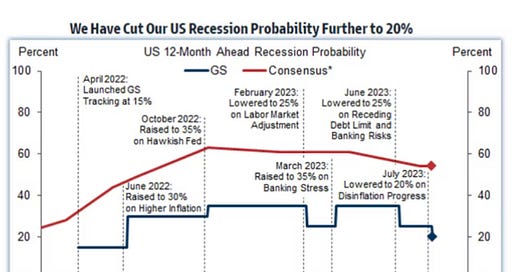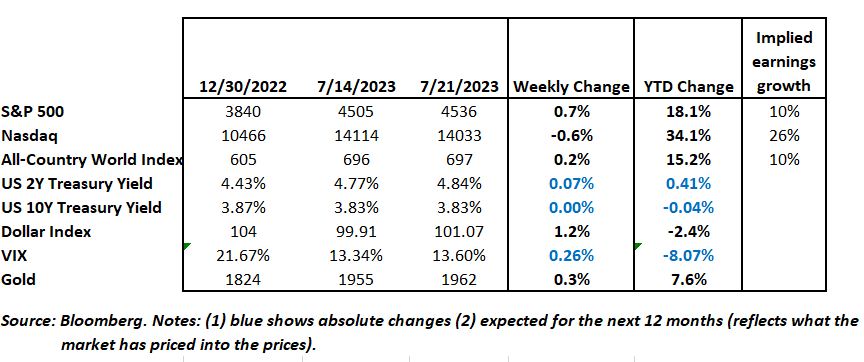Weekly Good Reads: 5-1-1
Soft landing, 3 rules of investing, Barbie's world, Circular Economy
Welcome to another issue of 5-1-1! I am Marianne O, an investment professional and author of The Learner’s Mind on investing, economy, and wellness ideas. For this Weekly, I include 5 links to relevant economic and investment news, finance, and wellness/idea pursuit based on what I read. I also include 1 important chart and 1 investment term to know. You can easily subscribe to my newsletter by clicking below.
Market and Data Comments
From the Bank of America July global survey, 68% of the fund managers saw an economic slowdown in the US but no recession while 42% expected artificial intelligence (AI) will increase profits over the next two years. The Fed may cut interest rates in Q2 of 2024.
The most crowded trades currently are long big tech (59% surveyed) followed by long Japanese equities, short Chinese equities, long Treasury Bills, and short US dollar and US Banks.
Economists are increasingly postponing or reducing the probability of inflation (red line below) in the next 12 months (Goldman lowered it to 20%).
There were relatively less data or drama in the market this week (see performance table below) except for the rebound in the Dollar Index (+1.2%) and some sell-off related to FANG-plus (10) high-tech stocks. Note these stocks were already up about 75% as a group this year.
Dollar strength reflects likely the ongoing strength of the US labour market (weekly unemployment claims declined), the strong expectation the Fed will raise rates next week, and the central bank of Japan will not hike interest rates in July (hence the weaker Yen vs. Dollar).
Inflation has turned the corner in the US and Europe, so the market expects both central banks to deliver the last rate hike next week. This is not the case for the UK, which has elevated (albeit falling) inflation and relatively high wage growth.
Next week, important events include the FOMC rate decision/press conference on July 26, the ECB rate decision on July 27, and China’s Politburo meeting (Q3) on July 28 for cues of any stimulus measures to buffer the disappointing economic growth. Read below what Morgan Stanley China economist thinks China will do—one word: measured!
We believe potential easing measures [in China] could include: (1) modest infrastructure stimulus via policy bank financing to cushion contracting LGFV [local government debt] net financing, with a focus on green capex and high-speed rail; and (2) relaxation of home purchase restrictions in large cities, i.e., a reversal of seemingly now-outdated policies that were enacted when the housing market overheated. Beijing may also indicate more room for interest rate/RRR cuts, which would facilitate financial conditions more conducive to diffusing debt risks.
~Morgan Stanley
Economy and Investments (Links):
Is a Recession Coming? Better Check Men’s Underwear Sales? (Barron’s or click here)—The theory goes that when the economy slows, men buy less underwear because, well, why spend on what isn’t seen?
A $500 Billion Debt Storm Builds Over Global Economy (Bloomberg or click here)—about 28% of the $590 billion of the corporate bonds and loans trading at distressed levels are related to commercial real estate (China, US). Also, watch out for problems in the consumer discretionary sector (advertising and casino).
Ark Invest ETF Q2 2023 Quarterly Report (Ark Invest)
Finance/Wealth (Link):
Our 3 Cardinal Rules of Investing! (DataTrek Research YouTube)
Never sell a new high, and never buy a new low.
Prospective losses hurt us psychologically about twice as much as equivalent-sized gains (based on Prospect Theory), e.g., people need a 20% upside but a 10% downside.
The market is never wrong, but the market is also always wrong (based on Efficient Market Theory).
When investing, pay respect to price momentum and your risk tolerance/ behaviour and really understand why a market rises and is valued higher (e.g. is it because of a higher return on equity) so it can continue to go higher (and vice versa —understand why a market is cheap).
Wellness/Idea (Link):
Inside Barbie’s World (The Circuit, an original series by Bloomberg)
I LOVE this episode. Do you know Mattel had three founders (Elliot Handler, Harold Matson, and Ruth Handler), but the woman’s name was excluded due to the circumstances at the time (the 1940s), and the founder of Barbie was Ruth? The company started in a garage just like modern-day startups. The development of Barbie showed how girls’ favourite dolls evolved with the wave of diversity and inclusion. Now Barbie has 23 skin tones and 9 shapes, representing as broad communities as possible.
One Chart You Should Not Miss: The Big Mac Index (The Economist)
The Economist magazine invented the Big Mac Index in 1986 based on the theory of purchasing-power parity (PPP), which posits long-run exchange rates between 2 countries should move towards the rate that would equalize the prices of an identical basket of goods and services. But it is unlikely the American and Japanese baskets of groceries contain the same products. However, a Big Mac is a Big Mac everywhere.
The Economist says this is a semi-humorous way of measuring whether the currency is at the ‘correct’ level, but it is not a precise gauge of currency misalignment.
The index compares the price of a Big Mac in a foreign country to that in a base country, both in their local currencies. For example, using the Big Mac index, the Swiss Franc (foreign country) is ‘overvalued’ by 35% against the U.S. Dollar (the base currency).

One Term to Know: Circular Economy
We take materials from the Earth, make products, and throw them away as waste—the ‘take-make-waste’ model, which is linear. However, a circular economy is a regenerative and sustainable system where materials continue to flow, and resources are continuously fed back into the economy, utilizing the resources for as long as possible.
It is based on three principles:
Eliminate waste and pollution
Circulate products and materials at their highest value
Regenerate nature
A circular economy is about getting the most value from our resources by keeping them at their highest utility and value.
Read the piece by
on the circular economy. Examples of companies that embrace this principle are Patagonia, which uses recycled materials in its products, and Apple, which offers repair services and trade-in programs for old iPhones.Please do not hesitate to get in touch if any questions! If you like this weekly, please share or subscribe to my newsletter.





